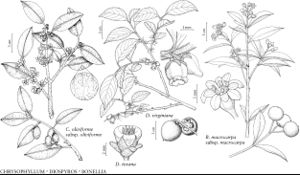Ebenaceae
Shrubs or trees, sap watery. Leaves alternate [rarely opposite or whorled], simple; stipules absent; petiole present; blade margins entire. Inflorescences axillary cymes [rarely racemes or panicles] or solitary flowers. Flowers unisexual, rarely bisexual; perianth and androecium hypogynous; sepals [3–] 4–5 [–8], connate at least proximally; petals [3–] 4–5 [–8], connate proximally; staminate flowers: stamens [1–] 3–4 [–5] times as many as [rarely fewer than] petals; filaments inserted on corolla-tube (rarely on receptacle), distinct or connate in superposed pairs; anthers dehiscent by longitudinal or subapical slits; pistillodes often present; pistillate flowers: staminodes often present; pistils 1, [2–] 4–5 [–8] -carpellate; ovary superior [rarely inferior], [3–] 8 [–16] -locular; placentation apical-axile; ovules anatropous, bitegmic, tenuinucellate, nucellus scant; styles [1–] 4 (–5) [–8], variously connate [distinct], often bifid apically; stigmas [1–] 4 (–5) [–8], apical. Fruits usually baccate [rarely capsular, tardily dehiscent]. Seeds 1–2 per locule or fewer by abortion, reddish or brown to black, ± oblong, usually bilaterally flattened; embryo straight to slightly curved; endosperm hard (sometimes ruminate), oily.
Distribution
Widespread in tropical and warm-temperate regions
Discussion
Genera 2–6, species 450–500 (1 genus, 4 species in the flora).
Generic inclusions and circumscriptions have been exceptionally varied in Ebenaceae, considering the number of genera. At various times and by various specialists over the past century, seven genera have been ascribed to the family; the most at one time usually has been five. Of the proposed members of the family, pantropical Diospyros and African Euclea Linnaeus are always accepted and treated as distinct from each other. South American Lissocarpa Bentham, which differs from Diospyros in its corona, inferior ovary, and other features, usually has been separated in a monotypic Lissocarpaceae. Molecular evidence unequivocally places it as sister to Diospyros and Euclea (P. E. Berry et al. 2001), so the APG II classification includes it in Ebenaceae (Angiosperm Phylogeny Group 2003); A. Cronquist (1981) and the original APG classification (Angiosperm Phylogeny Group 1998) kept it separate. The other four genera recognized commonly, pantropical Maba J. R. Forster & G. Forster and mostly African and Madagascan Rhaphidanthe Hiern ex Gürke, Royena Linnaeus, and Tetraclis Hiern, are now recognized either as distinctive elements of Diospyros at subgeneric or sectional rank, or as genera, but not always under the same names.
Only four species of a broadly circumscribed Diospyros (one representing the segregate Royena) and one each of Euclea (12 species) and Lissocarpa (four or five species) have been included in molecular phylogenetic studies. The relationship of the single species of Euclea to Diospyros is not yet resolved. Even if segregate genera were restored, the great majority of species in the family would still be retained in Diospyros in the narrow sense. None of the distinctive elements among the species of Diospyros is in the flora area, although D. texana was segregated by J. K. Small (1901) in his monotypic Brayodendron, a genus never taken up by any monographer of Diospyros or Ebenaceae. Many additional segregate genera were described and used locally without ever being accepted in the general literature of the family. A. Cronquist (1981) included Ebenaceae, along with Lissocarpaceae, Sapotaceae, Styracaceae, and Symplocaceae, in the traditional small order Ebenales; molecular studies (C. M. Morton et al. 1996; A. A. Anderberg et al. 2002; B. Bremer et al. 2002) show that these five families are nested separately or in pairs within an expanded Ericales. The closest relative of Ebenaceae (including Lissocarpa) is inconsistently determined among different studies, reflecting a general lack of resolution of family relationships within the Ericales.
Selected References
None.
